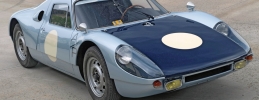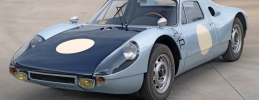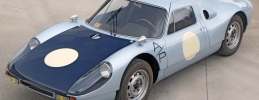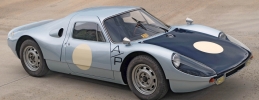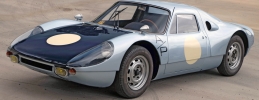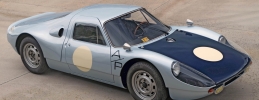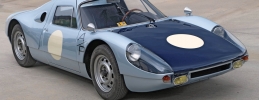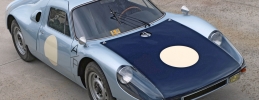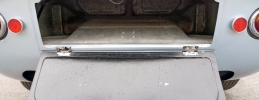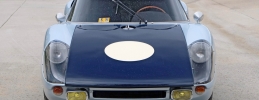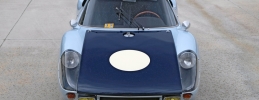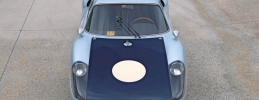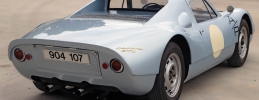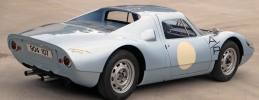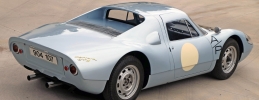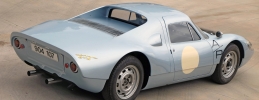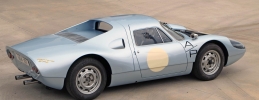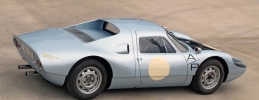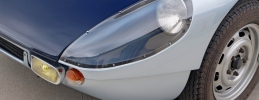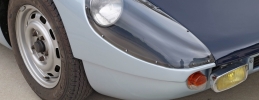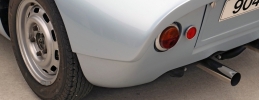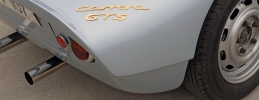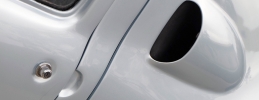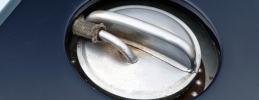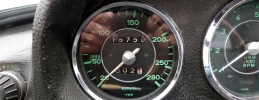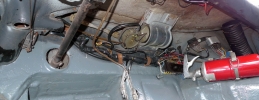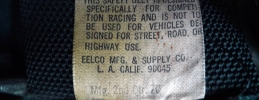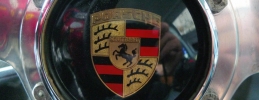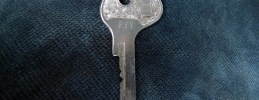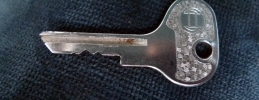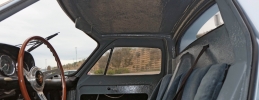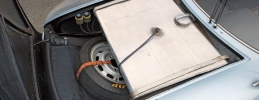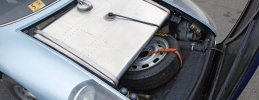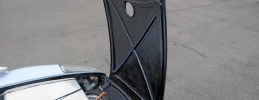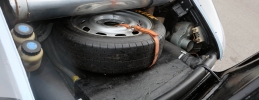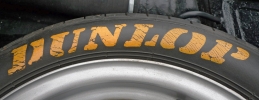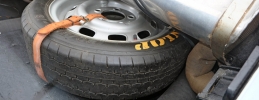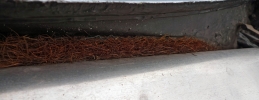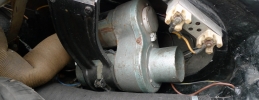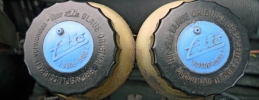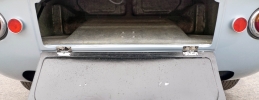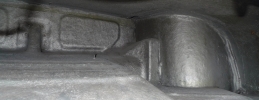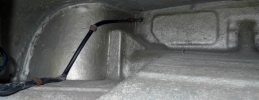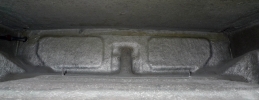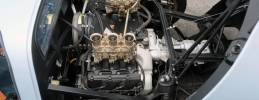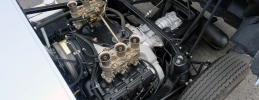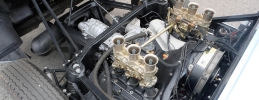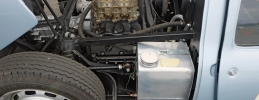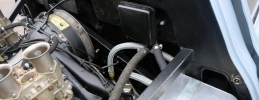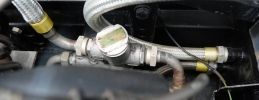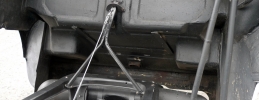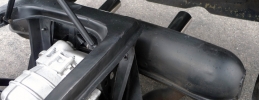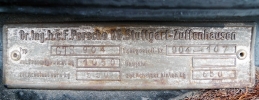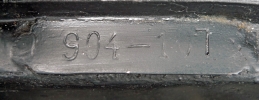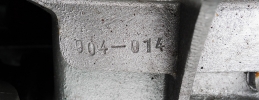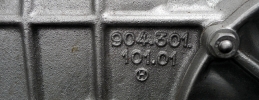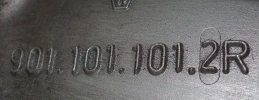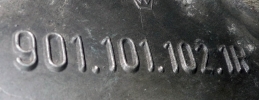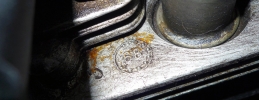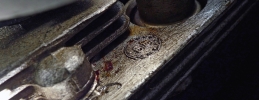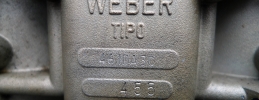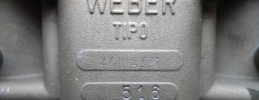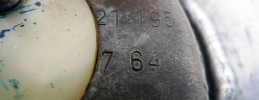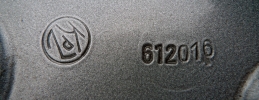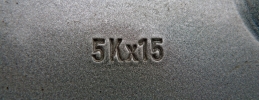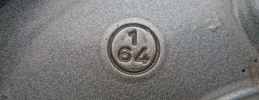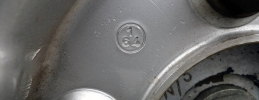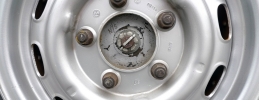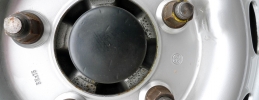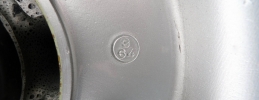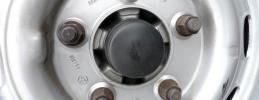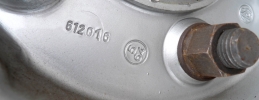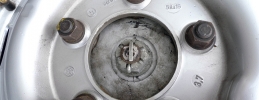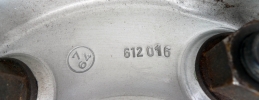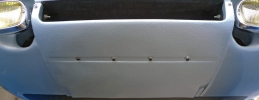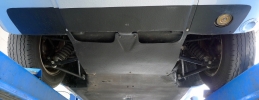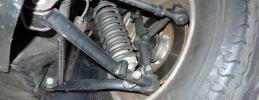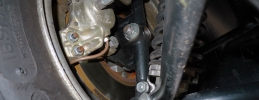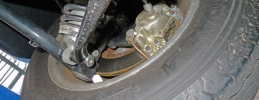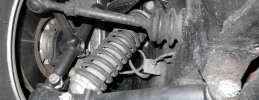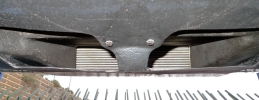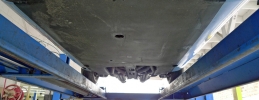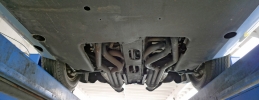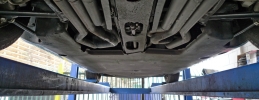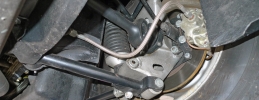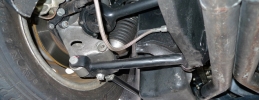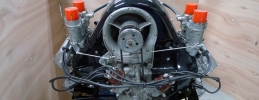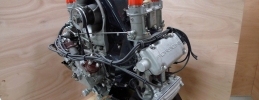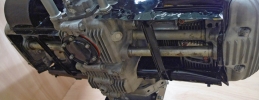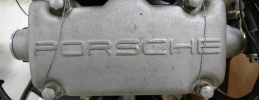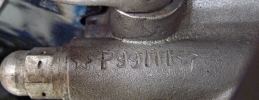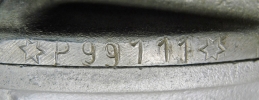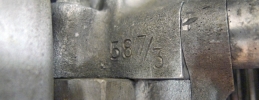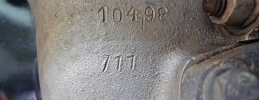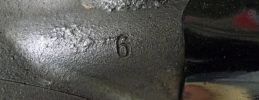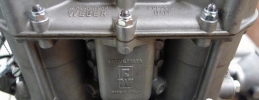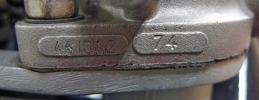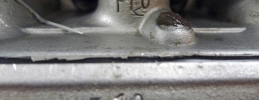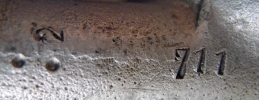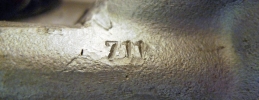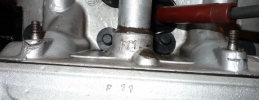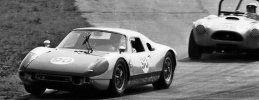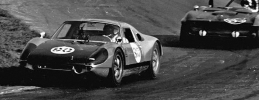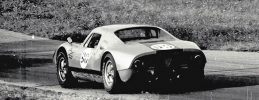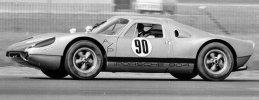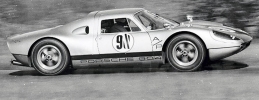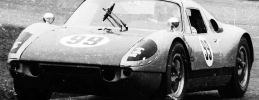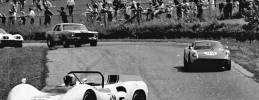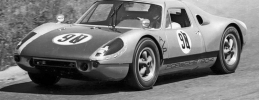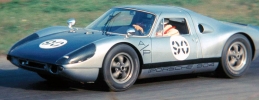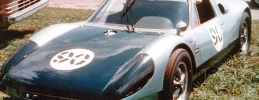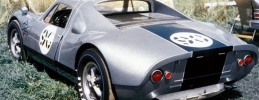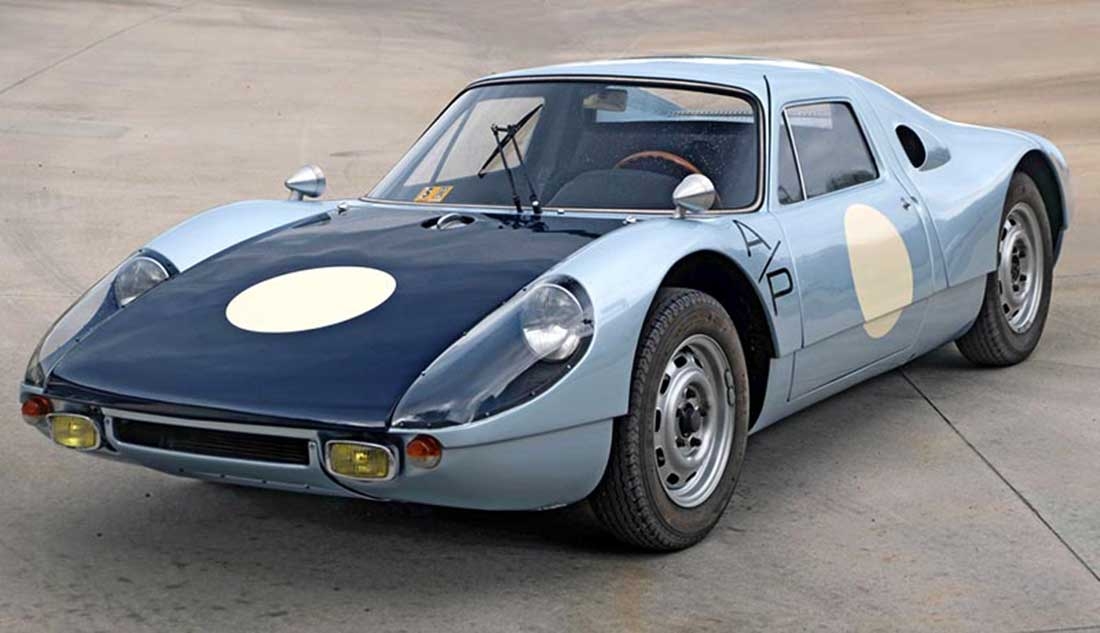
1965 Porsche 904 Carrera GTS
Chassis No. 904-107
Vehicle Specifications
| Stock No.: | 473 |
| Year: | 1965 |
| Make: | Porsche |
| Model: | 904 Carrera GTS |
| Type: | 2-door, 2-seat, FIA GT Coupé |
| Steering: | Left-Hand-Drive |
| Chassis No.: | 904-107 |
| Engine No.: | P*99 111* |
| Gear Box No.: | 904-014 |
| Exterior Color: | Light Blue Metallic |
| Interior Color: | Blue/Grey |
After having retired from F1 & F2 competition at the end of the 1962 season, Porsche focused again on SportsCar racing. The Porsche 904 debuted late in 1963, for the 1964 racing season, as a successor to the 718, which had been introduced in 1957. Porsche designed the 1965 Porsche 904 Carrera GTS variant to compete in the FIA-GT class at various international racing events. The street-legal version debuted in 1964 in order to comply with FIA’s Group 3 homologation regulations requiring a certain number of road-going variants be sold by the factory. Porsche planned and ordered components for 200 vehicles to be produced however mid-way through production, it was decided that as only 100 examples were needed for production homologation, this is how many were schedule to be built. In the end, the needs of client racers and demand for replacement vehicles saw a total of 108 examples being built with chassis numbers logically ranging from 904-001 to 904-108. There were several that were “recycled” in period and some rebuilt and issued same/old chassis numbers but today Porsche officially still sites a total of just 108 examples.
For the US market the 1965 Porsche 904 Carrera GTS had an initial list price of $7245 (FOB Stuttgart). Orders just exceeded the one hundred car requirement to satisfy homologation rules and more cars could readily have been sold, however Porsche had other plans and improvements in mind for the replacement 906 which was already on the drawing boards. The 1965 Porsche 904 Carrera GTS marked the beginning of a series of sportscars that eventually culminated in the mighty all conquering 917K first introduced in 1969
The Porsche 904 Carrera GTS mid-engine layout was inherited from the 718, also known as the RSK, the factory’s leading race car up to that point. It was powered by the 1,966cc, Type 587/3, four-cam, air-cooled, flat four-cylinder engine producing 200bhp. The design of which is considered buy many to probably be the most complex four-cylinder engine ever designed and put into production. The 2.0-liter engine drove a five-speed transmission with a standard 4.428:1 final drive ratio, with optional available ratios of 4.605, 4.260, 3.636, and 3.362. The original engine design began as the Type 547, its development first taking shape in 1953, when the previous VW-based 1,100cc, flat-four, used in the contemporary 356 hit the limit of its potential. Porsche realized it needed something all-new and it came in the form of the brainchild of Dr. Ernst Fuhrmann, later Technical Director of Porsche Racing. He initially hoped to achieve an unheard of 70bhp out of a 1500cc engine. Relying on hemispherical combustion chambers and two 46 mm, 46IDA3 dual-choke Weber carburetors, the engine was actually able to produced 100 to 115bhp depending on application and choice of cam, engine timing and allowable rpm applications. The new 1.5-liter engine weighed in at only 310lbs (140kgs) and eventually was producing nearly 180bhp in its final 1500cc form. Then engine featured a complex design that proved very expensive and time consuming to build but very durable. It was such a success that over a very short period of time, it was used in 34 different models, including the well-known 550 Spyders, 356 Carreras, and even Porsches short lived F1 and F2 programs.
The 904 was the first Porsche to use a ladder chassis and fibreglass inner and outer body appearing more like specialist racing cars than the modified sports cars typical of the period. The fibreglass body was bonded to its steel chassis for extra rigidity, and achieved a drag coefficient of only 0.34cd. While many German race cars had used unpainted aluminium bodies since the famous “Silver Arrows” of the 1930s, most 904s were painted silver, the German National racing colors. Unusually for Porsche, the two-seater bodies were provided by outside contractors, which would later become standard practice amongst race car builders. The 904’s fibreglass body was made by spraying chopped fibreglass into a mold, the amount sprayed often varied in thickness over the shape of the car and as a result the weight of the various cars was somewhat inconsistent; some were heavier than others. Race-prepared four-cylinder 904s weighed in at approximately 1,443lbs (655kgs) and the low weight gave the 904 the ability to accelerate to 62mph (100kmph) from a standstill in less than six seconds! They were also easily able to reach a top speed of 160mph (260kmph)
The Porsche 904 rode on coil springs (the first Porsche not to use trailing arm front and swingaxle rear suspension) with unequal-length A-arms in front. The wheelbase was 2,300mm and handling and with it’s mid-enigne design unlike anything before and regarded for some time thereafter as an industry benchmark.
This particular 1965 Porsche 904 Carrera GTS is identified on Porsche records as the 2nd to last of the 108 examples built. Porsche production details and research by Jürgen Barth and Jerry Pantis identify this 1965 Porsche 904 Carrera GTS as one of just four “Second-Series” examples which featured heavily revised, far more rigid and reinforced steel frames which necessitated “shorter” doors that had pull up side windows. Two seasons of endurance racing had shown several areas where the 904 needed improvement. Revised brakes, a more rigid chassis design, and the need for more rear downforce at speed necessitated Porsche’s engineers to update several late built examples. A design flaw of the oil system of the 587/3 engine at sustained high rpms alsos required an update to address oil-starvation issues. These four Series II 904s had the improved brakes and also a larger, “center-filled” fuel tank. A revised oiling system was developed and installed on the Type 587/3, four-cam engine that ensured they would not suffer oil-starvation at sustained high RPMs. The original engine fitted to this 904 was No. P*99 096*. This 1965 Porsche 904 Carrera GTS engine featured the “double” oiling system found on each of the four Series-Two 904s completed but which was often retrofitted during rebuilds on many Type 587/3 engines. High speed testing indicated a need for higher rear down-force for better top speed stability and these four vehicles received as such an improved rear tail section that incorporated a far more pronounced “Kamm” duck-tail giving these four 904s a unique and more purposeful look. 904-107 when completed was painted in standard Werks Team “Silbermetallic” paint-code “6206” or silver-grey metallic exterior paint. A standard grey painted interior with blue-cloth “Blau” seats as found in most production 904s was used on the inside.
Being a late Series-Two competition specification vehicle, chassis 107 was to some surprisingly finished with what many would think was an option suitable only for a road-car, namely a front-mounted gas-heater. This was done so for good reason as 904-107 shortly after completion was dispatched late in 1965 to Volkswagen Islandi, a dealership and the official Porsche, Audi, Volkswagen Concessionaire in Hekla, Iceland. It appears that rather than being sold, it was loaned or sent there for cold-weather testing as well as for promotional purposes. Today, this part of Iceland is frequently used by various manufacturers for testing as well as advertisement filming and photographing of various vehicles due to the uniquely “spartan” and extremely picturesque landscape. Volkswagen, Bugatti, Audi and Porsche still use this area for much of their promotional work and Audi won a series of prestigious marketing awards for the promotional film and photography taken there when the Audi TT made its world debut.
In 1967 with the 904 program at an end, Porsche deemed this vehicle surplus to their needs. It was returned briefly to the Porsche Factory and then sold to Autohaus Walter von Hoff, an official Volkswagen agent in Bad Kreuznach, West Germany. It was then offered for public sale and in late 1967 for roughly $6,000. It was soon purchased by American amateur racing driver, Dr. Carl Armstrong of Toledo, Ohio. Armstrong had been in search of a replacement racer for Mid-West SCCA racing and decided a new 906 or 910 was out of his reach. The more affordable Porsche 904s he had found up to that point had been far too used and abused and finding a near new example was quite fortunate. After agreeing to the purchase and arranging for payment, Autohaus Walter von Hoff then arranged shipped Armstrong’s new Porsche by ocean vessel to New York.
Upon arrival in the States, Dr. Armstrong cleared the vehicle through US Customs himself at the Port of New York City and drove it back to his home in Ohio. Armstrong took his racing and race preparation seriously and was noted for doing most work himself with little to no outside assistance with the exception of some occasional help from his brother. Shortly after arrival, his new 1965 Porsche 904 Carrera GTS sported a light metallic blue paint scheme which the car would wear prominently over the next two race Seasons in both 1968 and 1969. Research by Jerry Pantis and Jim Perrin documents much of Armstrong’s track success during this time-frame. Armstrong usually sported No. 90 for a race number and was an active participant in the SCCA Central (Mid-West) Division. In addition to surviving race results are countless period black and white as well as rare color photos of chassis 904-107 tearing up the track.
On August 24, 1968, Dr. Armstrong won the A Production race at Waterford Hills, Michigan; came 2nd in class at Waterford Hills on September 14; won 1st again at Waterford on September 28 and again on October 6 at Steel Cities; and came in 4th at Mid-Ohio October 13.
Dr. Armstrong had always wanted a 906 or 910 and by 1969, prices on used examples had started becoming more reasonable. He continued to compete with his 904 for that year’s race Season but only until he was able to make a deal and purchase a second-hand 906. His mentor and good friend, Bob Fergus, owner of Midwest Volkswagen (MidvoCo) in Dublin, Ohio had assisted him with the understanding that he would have first chance to buy Armstrong’s 904.
Not long after purchasing 904-107, Fergus prepared it for road use by repainting it white with yellow trim and installing carpeting and more comfortable seats to support his large frame. Not long after this work was completed, a change in plans saw the car being sold to “Uber” Alabama Porsche enthusiast, George “Jerry” Reilly who immediately put the car back to race configuration which included going back to the original silver-grey metallic exterior color and the fitting of a new 904 gearbox and competition-based 911, 2.0-liter engine.
Reilly eventually moved to Massachusetts, and over the next 30 years, he and his Son enjoyed the car immensely on the road and track. Reilly never raced the 904 but it was entered regularly in Porsche club events and outings, many of which took place at his home track, Lime Rock Park in Connecticut.
In 2001, Reilly initiated an overhaul of his prized 1965 Porsche 904 Carrera GTS and installed four-cam 904 engine No. P*99 088* that was in the car when it was sold new to Dr. Armstrong. Later that year Reilly consigned the car to Paul Russel and Company in Essex, Massachusetts where it was advertised for public sale. In the Fall of 2001, the car was thoroughly inspected and evaluated by East-Coast Porsche historian, dealer and collector, Weldon Scrogham on behalf of his client, Cal Turner. A sale was eventually agreed upon at which time the car had covered just over 16,145 original kilometers from new.
Soon after purchasing this Porsche, Turner entered it in several historic races, unfortunately, the four-cam engine seized during a race at Summit Point, in West Virginia. As had Reilly in the past, a 911-based, 2.0-liter engine was installed and the damaged four-cam was sold to Lothar Hoess, the owner of a sister-904, chassis No. 904-100, the car in which that engine was originally installed. In 2005 Turner agreed to the sale of this Porsche via Scrogham and California dealer, Herve Willems/Heritage Classics. The car was then sold to Edgar Starke Flandeshagenthur, a private collector from Monaco and formally imported to Europe.
In 2007, the 1965 Porsche 904 Carrera GTS was purchased by a client of noted restores, DK Engineering of Hertfordshire, England. They were soon tasked and performed a comprehensive and total restoration that retained as much of the car’s original components as possible. Since the completion of this work the car has joined a significant Porsche and VW collection and has been used sparingly covering just shy of 400 additional kilometers in that time-frame.
Chassis number 904-107 is offered here race-prepared and in full roadworthy condition, being fitted with a period correct, 2.0-liter, magnesium-case, single-plug 911engine. It is currently fitted with two triple-throat downdraft Weber 40IDA carburetors. Quite surprisingly, it is still fitted with its original Nadella axle shafts, Eberspacher gasoline heater, fuel surge tank in the nose compartment, the coconut-fiber matting beneath the front-mounted gas tank, and a set of original1964-dated steel and alloy 5.5-inch wide 904 competition wheels, which are believed to be original to this car. The interior features a period-correct Les Leston wood-rimmed steering wheel. This is a highly original 904 and something of an oddity as few truly original examples survive. A recent and thorough inspection was carried out by a leading Porsche expert, and documentation from this inspection is on file and available for review.
Included in the sale of this 1965 Porsche 904 Carrera GTS is a period correct, original 1964 Type 587/3 904 engine (number P*99 111*) which has been mounted on a proper display stand. It is understood that this motor is listed by Porsche as having been a spare engine for the 1965 Targa Florio and not assigned to a specific car when new. The engine was comprehensively inspected and tested to confirm that it has been rebuild and is indeed in good health and could easily be fitted back to this 1965 Porsche 904 Carrera GTS.
Please contact me for additional assistance in arranging an inspection or with any other requests regarding the potential purchase of this vehicle.


